Excerpts from Jim Conrad's
Naturalist Newsletter
from the November 2, 2018 Newsletter with notes from a camping trip into northern Guatemala's Petén department
"BIG SENNA"
Also during my recent camping trip south to El Rosario National Park, on Sayaxaché's east side in northern Guatemala's Petén department, on October 1, a conspicuous tree in the park's campground turned out to be a species I've been wanting to see. Below, you can see its substantial trunk and identification sign
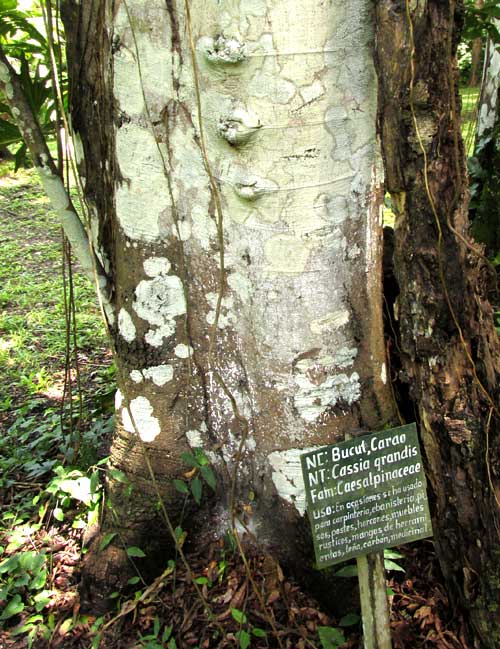
The sign gives its local names as Bucul and Carao, though in southern Mexico the name Cañadonga seems to be preferred. It's CASSIA GRANDIS, a member if the huge Bean Family, native from southern Mexico southward at least to Costa Rica. The grandis in the name hints at why I've wanted to see it. It means "big," yet all the Cassia species I know are small trees, bushes or even herbs. There's no good English name for Cassia, so my "Big Senna" is a made-up one. Often members of the genus Cassia are known as sennas. When you know a few Cassia species, seeing such a big one as this is a real surprise.
The tree's leaves, however, looked like you'd expect of a Cassia, as shown below:

Cassia leaves are "even pinnate," meaning that they're once-compound, with an even number of leaflets on each side of the leaf axis, or rachis, with no lone leaflet at the rachis tip.
The campground's Cassia rosea trees were neither flowering nor fruiting, the literature indicating that in our area the species' pink, Redbud-like flowers appear mostly from late February to mid April. At the campground, the tree's huge legume-type fruits must have reached maturity in August or September, because several in various states of decay still lay on the ground on October 1. Below, you can see a couple:
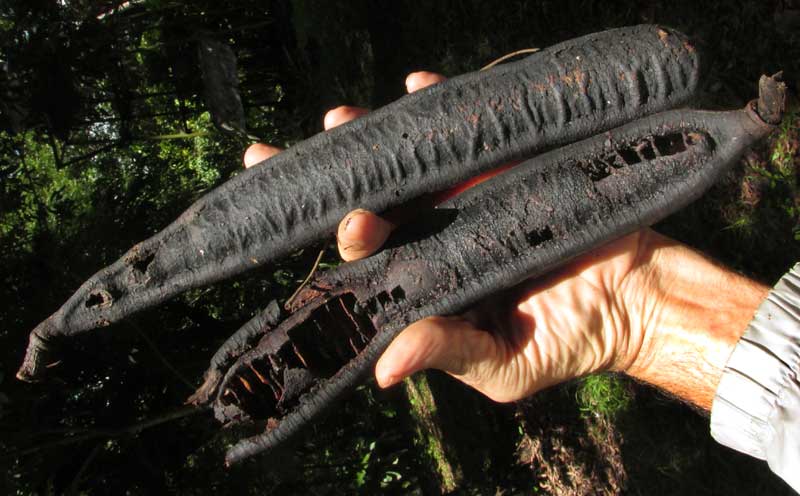
The fallen-away legume wall of the bottom fruit shows empty seed (bean) chambers. Numerous beans in the pod's crosswise partitions is a feature of many Cassia species. By the way, in the picture I'm wearing a jacket not because it was a cold day in Guatemala, but because it helped keep the mosquitoes off.
The sign at the tree's base also said that sometimes Cassia grandis wood is used in carpentry, cabinet-making, floors, posts, rustic furniture, tool handles, firewood, charcoal, for medicinal purposes, and something else I can't read. On the Internet I read that medicinally it's used to cause abortions, as a remedy for various chest problems, and also just as a drink.
from the April 20, 2019 Newsletter with notes from a camping trip into northern Guatemala's Petén department
"BIG SENNA" SPECTACULARLY FLOWERING
This month, on April 3, toward the end of the dry season, I was back in the campground at El Rosario National Park on the east side of Sayaxaché and I got to see fruits still hanging on the Big Senna trees, along with pinkish, redbud-like flowers, as shown below:
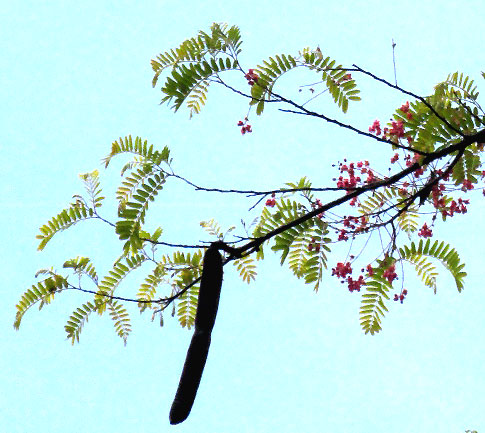
This time, however, it wasn't the legumes that were so impressive, but rather the pink blossoms. The big trees looked like huge heaps of strawberry sherbet. They were crowded among other species so no picture was possible showing the effect at a distance, but at least a telephoto shot of flowers high in the canopy showed how densely the blossoms arranged themselves among the branches, shown below:
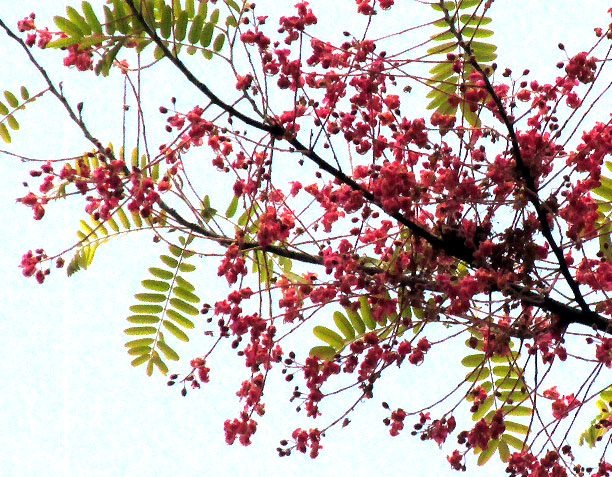
All the flowers were too high to reach, but the ground was prettily carpeted with dropped blossoms. If I'd had watercolors and a blank canvas, I'd have tried to paint the abstract picture shown below:
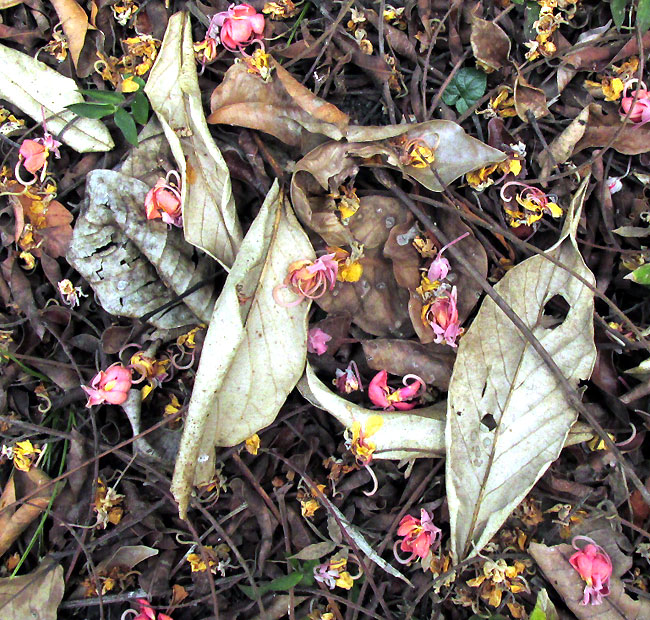
With so many blossoms falling, it's clear that only a very small percentage of flowers ever set fruit. If all them did produce the big, heavy fruits, the branches would collapse or the trees fall over. Below, you can see a blossom retrieved from the ground:

Cassias are members of the Bean Family. Flowers of most species in that family either are of the bean-vine type, with a large top petal, two side ones, and two below fused along their common margin into a scoop shape (they're "papilionaceous") or else they're very small and cylindrical, clustered in powderpuff-like heads. However, this blossom isn't like that. It bears five separate petals of almost equal size and shape, and its stamens vary greatly in length. These features assign cassias to the Caesalpinia Subfamily of the Bean Family, the Caesalpinioideae.
A flower feature not showing in the above photo is that the flowers' calyxes are distinctly large, tough and hairy, as shown below:
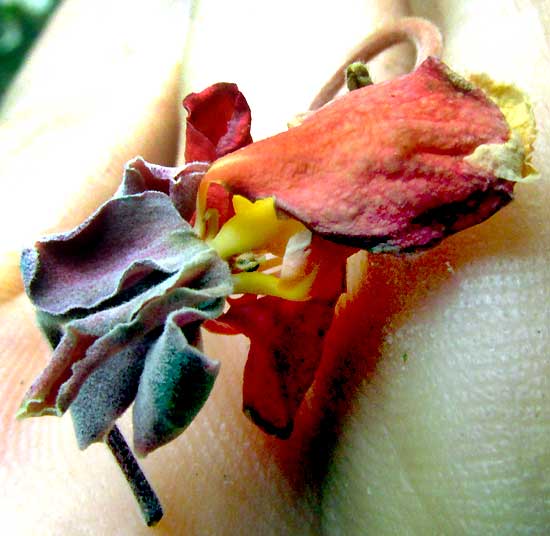
So, these "Big Sennas" are wonderful trees. At this torrid, most stressful time of the current dry season, when so many trees have lost their leaves and many herbs have simply died back, what a gift the Big Senna's flowers are to pollinators, and all those other beings dependent on those pollinators at other times of the year.